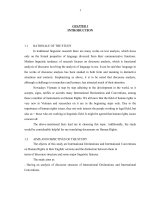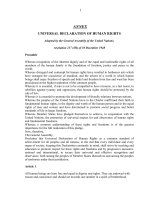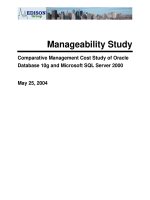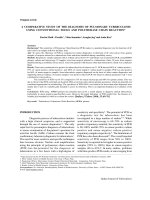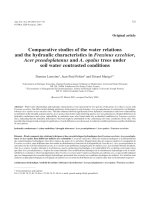Comparative study of training need assessment of agri-entrepreneurs under agri-clinics and agri-business center scheme in India
Bạn đang xem bản rút gọn của tài liệu. Xem và tải ngay bản đầy đủ của tài liệu tại đây (459.59 KB, 11 trang )
Int.J.Curr.Microbiol.App.Sci (2019) 8(4): 2287-2297
International Journal of Current Microbiology and Applied Sciences
ISSN: 2319-7706 Volume 8 Number 04 (2019)
Journal homepage:
Original Research Article
/>
Comparative Study of Training Need Assessment of Agri-Entrepreneurs
under Agri-Clinics and Agri-Business Center Scheme in India
Taufiq Ahmad1*, Shamsul Hasan2, Rifat Haneef2 and Manoj Kumar Riyal1
1
College of Forestry, VCSG Uttarakhand University of Horticulture and Forestry, Ranichauri,
Tehri Garhwal, Uttarakhand, India
2
Deptartment. of Agricultural Communication, Govind Ballabh Pant University of
Agricultural & Technology, Pantnagar, Uttarakhand, India
*Corresponding author
ABSTRACT
Keywords
Agri-entrepreneur,
Training need,
Agri-clinics, Agribusiness, Weighted
mean score, Rank
Article Info
Accepted:
17 March 2019
Available Online:
10 April 2019
Training need assessment is considered to be the integral part of well designed training
programme. Training needs are closely linked to learning: the target population is looked
at more closely to determine the actual content, context and delivery method of
performance intervention. Present study was conducted in two states of India i.e.
Uttarakhand and Punjab to assess the training needs of the agri-entrepreneurs. One training
center from each state were randomly selected and total 120 respondents, 60 from each
state were selected using simple random sampling method. The data were collected with
the help of semi- structured interview schedule and were analyzed using Statistical
Package for Social Sciences (SPSS). Findings revealed that self motivation for own
business was one of the major factors, which got the first rank in Punjab and 2 nd rank in
Uttarakhand. Efficient utilization of resource base (education, knowledge, land etc)
obtained 1.88 WMS in Punjab and got second rank, whereas the same factor has scored
2.15 WMS and ranked 1st in the Uttarakhand. Training need of agri-entrepreneurs was
higher in the area of agribusiness management with scores of 14.15. The relation between
ranks and weighted mean score of states Uttarakhand and Punjab has been studied and
found that they followed Zipf-Mandelbrot law (Inverse Power law) (Figure 1, Figure 2) for
distribution of respondents for the factors that motivated respondents to join the training
programme and linearly increases for the Distribution of respondents according to their
training needs assessment with their ranks (Figure 3).
Introduction
Agri-entrepreneurship
development
is
increasingly seen as a promising alternative to
traditional economic development, as it
unlocks the potential of unemployed
agricultural graduates to create job
opportunities and strengthen agricultural
extension system. After independence,
conscious efforts were made towards
economic and social transformation in India,
followed socialistic pattern of development
policy within the framework of five year plan
(Tiwari, 2007). Accordingly government
concentrated on the development of
infrastructure for industrial and agricultural
2287
Int.J.Curr.Microbiol.App.Sci (2019) 8(4): 2287-2297
development. Thus, it was during late sixties
that the small-sector began to be recognized
as an instrument for tapping entrepreneurial
talent. In the initial stages government
envisaged a promotional package to facilitate
setting up of units (Report of prime minister
task force in micro, small and medium
enterprises, Government of India, 2010). It
consisted of financial assistance and
incentives, infrastructural facilities technical
and managerial guidance through a network
of a number of support organizations of
central, state and local levels. But the
insufficient progress of this sector however
made the planners to realize that facilities and
incentives were necessary but not sufficient in
themselves to ensure adequate entrepreneurial
response. In fact, entrepreneurial growth
required focus on the human resource
development more than anything else did
(Ahluwalia, 2002).
Agri-entrepreneurship is an employment
strategy that can lead to economic selfsufficiency
of
rural
people.
Agrientrepreneurship
development
through
training is a key element for the promotion of
Micro, small, medium enterprises (MSMEs),
particularly, the first generation agrientrepreneurs (Ahmed 2011). In 1991, India
began a process of economic liberalization,
including new economic policies with a
specific focus on fiscal, structural and
industrial reform. Among the structural
reforms the abolition of archaic industrial
licensing policies and a quota system, both of
which had inhibited market entry. The
removal of these barriers was chiefly intended
to increase private investment and expand
entrepreneurial opportunities (Ahluwalia,
2005). Consistent with past policies, these
structural reforms also included increased
support for self-employment initiatives, with
the
primary
goal
of
decreasing
unemployment. However, convergence of
unemployment rates was not found before and
after the reform period. Added to that, a longterm sustenance of unemployment rates was
prevalent throughout India (Bhalotra, 2003).
The regions within India differ in
unemployment rates and that, surprisingly,
states with the highest incidence of poverty
appear to have the lowest unemployment rates
and vice versa, making it more than a little
puzzling that self-employment policies for the
unemployed are still viewed as a viable
method of alleviating poverty (Ahluwalia,
2005). In this connection, Government of
India constituted a steering committee on
agriculture and allied sectors under the
chairmanship of Dr. M.S. Swaminathan. The
committee, among others, suggested creation
of Agriclinics and Agribusiness Centers
managed by Agricultural graduates so as to
provide consultancy services to the farming
community in rural areas. Subsequently, a
scheme for setting up of Agriclinics and
Agribusiness centers by agricultural graduates
was announced by the then finance minister
on February 28, 2001. NABARD has
formulated a model scheme for financing
Agriclinics and Agribusiness Centers. This
scheme is being implemented jointly by
NABARD, MANAGE and SFAC since from
9th April, 2002. The objective of the present
investigation was: To identify the training
needs of trainees under the scheme of
Agriclinics and Agribusiness centers.
Materials and Methods
The present study carried out two states of
India i.e., Uttarakhand and Punjab, because
both the state has huge potential for
agricultural graduates to establish and run
their agri-ventures. This empirical study
focused on training needs of the trainees who
have taken training from the two training
centers College of Agribusiness management
(CABM), Pantnagar, Uttarakhand and Indian
society of agribusiness professional (ISAP),
Amritsar, Punjab. These were selected
2288
Int.J.Curr.Microbiol.App.Sci (2019) 8(4): 2287-2297
randomly for the present study under the
scheme of “Agri-clinics and Agri-business
center scheme”. Motive of the scheme is to
provide expert services, advice, input supply
and farm equipment to the farmers by Agriclinics and Agribusiness centers. In this study,
we have gone through the following ways:
List of agri-entrepreneurs was collected from
both above mention training institutes. After
that respondents were selected with the help
of simple random sampling by using chit
method. The data was collected from 120
respondents in the investigation. A sample of
60 each was selected from both the sates. In
some cases snow-ball sampling was used for
taking data because it was difficult to explore
individual agri-entrepreneurs. This sampling
method is highly helpful to the researcher for
tracing the agri-entrepreneurs.
Interview schedule was used as a tool for
collecting data in face to face situation. Each
and every part of the interview schedule was
thoroughly examined and discussed with the
advisory committee before giving it a final
shape. The interview schedule was validated
by experts related to the field.
The tool was pilot tested in the field
conditions, on 30 non sample respondents.
The necessary modifications, alterations and
suggestions
were
incorporate
before
conducting the survey.
The interview consists with of both close and
open ended questions related to the socio
personal, socio economic, entrepreneurial
characteristics and general information. Data
gathered by personally visiting to agrigraduates who engaged in agri-based
enterprises.
Z-test has been applies for comparing the
Socio economic attributes of the agrientrepreneurs of Uttarakhand and Punjab state
of India. Then, a simulation has been
performed and statistical analysis by using ttest was done by using weighed mean scores
and their corresponding ranks.
Results and Discussion
The compression between Socio economic
attributes of the respondents of Uttarakhand
and Punjab for instance Socio-personal
characteristics (Age, Education, Cast, Year of
Experience), Socio-economic characteristics
(Source of earning, Land Holding, Social
participation, Possession, Family Size),
Entrepreneurial characteristics (Achievement
Motivation, Risk taking ability, Leadership
ability,
Decision
making
ability,
Innovativeness, Management orientation, Self
confidence, Information seeking) has been
studied by applying Z-test (Table 1).
Data revealed that there was significant
difference between the socio-personal
characteristics of agri-entrepreneurs in respect
of their age (Z=1.98*) but there is no
significant difference in education, caste and
year of experience. Significant difference
between age might be due to younger
generation involved
in
agripreneurial
activities.
In case of socio-economic difference in agrientrepreneurs, significant difference was
found with respect to their socio-economic
variables like social participation (Z=1.97*),
land holding (1.98*) keeping aside source of
earning, possession and family size with no
significance difference in between.
Further the data in Table 1 revealed that a
significant difference was found between the
entrepreneurial characteristics of agrientrepreneurs in respect of risk taking ability
(Z=1.99*) keeping aside no significant
difference between other entrepreneurial
characteristics.
2289
Int.J.Curr.Microbiol.App.Sci (2019) 8(4): 2287-2297
Factors motivated to join the training
programme
Factors motivating respondents to take up
training
under
the
Agriclinics
and
Agribusiness center scheme are presented
(Table 2). It revealed that self motivation for
own business was the main factor, got the first
rank in Punjab and 2nd rank in Uttarakhand
with 2.12 and 2.05 WMS respectively. This
was mainly due to interest of the graduates to
take up own business. The second important
factor in the Punjab states was found to be the
efficient utilization of resource base
(education, knowledge, land etc) with the
obtained 1.88 WMS, whereas the same factor
has got 2.15 WMS and ranked 1st in the
Uttarakhand state. This might be due to the
technical knowledge of agri-entrepreneurs
and their interest in the efficient utilization of
government
benefits
by
undertaking
Agriclinics and Agribusiness centers. Better
institutional linkage was found to be the 3rd
most important factor in both selected states
Uttarakhand and Punjab as this training
programme with the 1.95 and 1.87 WMS
respectively, gives the linkage of financial
Institutions,
agriculture
department,
NABARD,
MANAGE,
agriculture
universities, successful agri-entrepreneurs.
On the basis of scores in each category
weighted mean score values were calculated
for each dimension. Low scores in each
dimension means the respondents were
having poor knowledge or skills in that area.
So, the respondents required training in that
area.
It is interesting to note that free specialized
training got fourth rank in Punjab obtained
1.83 WMS and same factor got 5th in
Uttarakhand state with 1.66 WMS, is
important factor to join the training
programme in the states. Problem of
Unemployment is an important factor which
made them to join the training programme has
4th rank in Uttarakhand state; obtained1.67
WMS and same factor got 5th rank in Punjab
state with 1.83 WMS. It shows that
unemployment is also big factor which
motivate agricultural graduates to join this
training programme. Non-remunerative yields
from present farming system got 6th rank in
Punjab state with 1.75 WMS and same factor
got 8th rank in Uttarakhand state and obtained
1.60 WMS. The factor which has got 7th rank
in Punjab state, it was Access to credit facility
with 1.65 WMS and this factor got 6th rank in
Uttarakhand state obtained 1.61 WMS.
Improved market outlets were 7th important
factor in Uttarakhand state with 1.59 WMS
was 8th important factor in Punjab state with
1.59 WMS. Similarly, better price
expectations from the activity undertaken was
9th important factor in Uttarakhand state with
1.54 WMS was 10th rank in Punjab state
obtained 1.45 WMS. The 10th important
factor in Uttarakhand state was joining the
training programme to get free food and
accommodation in the city for searching the
jobs with 1.52 WMS and same factor got 9th
rank in Punjab state with 1.45 WMS.
Increasing cost requirements got same rank
11th in both selected states with 2.15 and 1.88
WMS respectively, was least important factor
for joining the training programme under the
scheme of Agriclinics and Agribusiness. Rank
of all factors shows their seriousness of the
training programme and zeal to start their own
business. These finding are supported by
earlier studies (Karjagi, 2005) who reported
that these factors are important to motivate for
joining training programme.
After simulation of Distribution of
respondents according to factors that
motivated respondents to join the training
programme it has been found that the
distribution of weighted mean scores of
Uttarakhand
and
Punjab
and
their
2290
Int.J.Curr.Microbiol.App.Sci (2019) 8(4): 2287-2297
corresponding ranks (Figure 1) have followed
Zipf-Mandelbrot law (Zipf, 1949; Yadav,
2010) Zipf-Mandelbrot law is
Training needs assessment of trainees
under agriclinics (ACs) and agribusiness
centers (ABCs) scheme
log f = log a – b log (r + c)
Training needs of agri-entrepreneurs was
analyzed in various areas like agribusiness
management, small business management,
general marketing management, agrimarketing
management,
financial
management and information technology.
Where a and b are constants and b is known
as Zipf’s exponent and f and r are weighted
mean scores and ranks respectively. For state
Uttarakhand the values of a= 2.225 and b = 0.1748 and for state Punjab a = 2.171 and b =
-0.1529 respectively.
Based upon the weighted mean scores of both
states (Uttarakhand and Punjab) of
distribution of respondents for the factors that
motivated respondents to join the training
programme t-test has been applied by using
the formula:
……………………..…..(a)
t=
and
are the means of weighted mean
scores,
and
are size of weighted mean
score of Uttarakhand and Punjab respectively
and S is the c ombined standard deviation of
the both states, which can calculated as:
S=
……………..……(b)
The calculated value of t from above equation
(a) was 2.03567(+ ignored) and the critical
value at 5% (p<0.005) significance level was
2.228, which was greater than the calculated
value. Hence the differe4nce between mean
scores of Uttarakhand and Punjab was not
significant i.e., the mean of weighted mean
score were approximately same for all the
factors taken in our study.
The Table 3 depicted the rank order of the
different areas in which the trainees required
trainings under the scheme of ACs and ABCs.
The need of agri-entrepreneurs was higher in
the area of agribusiness management with
scores of 14.15. It might be due to the reason
that respondents lacked knowledge regarding
different aspects of agribuisness management
such as forms of agribusiness organization,
their advantages and disadvantages, scope of
agribusiness, status, present role and future
prospects, agribusiness development analysis
and opportunities and agribusiness concepts,
nature and scope etc. So, the trainees were
showed great interest to learn about these
things through training programme followed
by the need of managing small business had
ranked second (16.24) which included
different aspects of training on small business
management such as operating franchise,
importance of franchising, pit falls in
franchising identification, development and
diversification of small business, marketing
and components and characteristics of small
business etc. which means the respondents
were eager about to established their small
businesses. So that’s why they want training
in this area under the scheme of Agriclinics
and Agribusines centers. The need of
financial management was ranked third
(19.26) because during the time of
investigation respondents expressed that they
were not very much aware about the different
facet of handling the financial aspect like
preparing projects for bank appraisals, project
2291
Int.J.Curr.Microbiol.App.Sci (2019) 8(4): 2287-2297
analysis techniques, analyzing projects,
appraisals and reports, capital expenditure
decisions etc.
Agri-marketing management need was ranked
fourth (22.49) which includes quality issues,
standardization, grading and packaging, crop
insurance,
procurement
management,
franchise issue, problems and prospects, preharvest
planning
services,
marketing
environment of seed fertilizers etc. followed
by the need of Information technology had
ranked fifth (26.39) which cover the
information related to various aspects like
existing agricultural management information
system (MIS) and its commercial use
followed by commercial dissemination of
information, E-commerce, its scope and local
application, kiosks, internet and MS-Office,
agricultural portals, IT application and their
advantages, Role of IT in changing business
with special reference to small business,
linking procedure to it led applications and
brief introduction of information technology.
Mean score value was higher in case of
general marketing management (38.14). It
means that trainees of the study area were
aware about the different issues of rural
marketing,
advertising
management,
marketing of services, sales operations and
management,
sales
promotion,
retail
marketing, pricing and price policies etc.
Table.1 Comparison between Socio economic attributes of the respondents for agripreneurs of
Uttarakhand and Punjab
S.No
Variables
Mean
Uttarakhand Punjab
n1=60 n2=60
A. Socio-personal characteristics
Age
1
Education
2
Caste
3
Year of experience
4
B. Socio-economic characteristics
Source of earning
5
Land Holding
6
Social participation
7
Possession
8
Family size
9
C. Entrepreneurial characteristics
Achievement
10
Motivation
Risk taking ability
11
Leadership ability
12
Decision making ability
13
Innovativeness
14
Management orientation
15
Self confidence
16
Information seeking
17
Variance
Uttarakhand Punjab
n1=60 n2=60
‘Z’ value
35.27
1.55
3.51
1.55
33.70
1.46
3.06
1.53
41.45
0.52
0.43
0.48
33.02
0.32
1.14
0.45
1.98*
0.70
0.63
0.13
1.60
2.85
2.23
2.98
2.38
1.58
3.03
2.56
3.13
2.45
0.48
1.51
0.99
0.66
0.30
0.41
1.82
1.13
0.72
0.28
0.13
1.98*
1.97*
0.98
0.67
11.68
11.91
4.38
4.92
0.69
7.31
10.21
15.61
11.85
5.30
5.31
13.25
7.65
10.48
15.85
12.28
5.51
5.53
13.40
2.52
4.95
11.18
9.82
1.80
1.94
7.27
1.72
4.83
10.19
10.20
1.98
1.64
7.39
1.99*
0.66
0.39
0.74
0.86
0.88
0.30
* Significant at 0.05 level of probability
2292
Int.J.Curr.Microbiol.App.Sci (2019) 8(4): 2287-2297
Table.2 Distribution of respondents according to factors that motivated respondents to join the
training programme
S.No.
1.
2.
3.
4.
5.
6.
7.
8.
9.
10.
11.
Factors
Uttarakhand N=60
WMS
Rank
Unemployment problem in government and
1.67
IV
private sector
Non-remunerative yields from present
1.60
VIII
farming
Self motivation for own business
2.05
II
Free specialized training
1.66
V
Better institutional linkage (training, credit
1.95
III
and marketing)
Improved market outlets
1.59
VII
Access to credit facility
1.61
VI
Better price expectations from the activity
1.54
IX
undertaken
Increasing cost requirements.
1.34
XI
Efficient utilization of resource base
2.15
I
(education, knowledge, contracts, land etc)
Joining the training programme to get free
1.52
X
food and accommodation in the city for
searching the jobs
Punjab N=60
WMS
Rank
1.83
V
1.75
VI
2.12
1.83
1.87
I
IV
III
1.63
1.65
1.45
VIII
VII
X
1.37
1.88
XI
II
1.45
IX
Table.3 Distribution of respondents according to their training need assessment N=120
S. No.
Areas of training courses
I.
1.
2.
Agribusiness Management
Agribusiness concepts, nature and scope
Scope of agribusiness status, present
role and future prospects
Forms of agribusiness organizations,
their advantages and disadvantages
Agribusiness development analysis and
opportunities
Small business management
Components and characteristics of small
business
Managing small business
Marketing and services
Small business networking
Identifying, developing and
diversification of small business
Operating franchise importance of
3.
4.
II.
1.
2.
3.
4.
5.
6.
Weighted mean
score value of each
item
Rank
3.71
3.65
IV
III
3.18
I
3.61
II
2.46
I
2.49
2.86
2.99
3.19
II
IV
V
VI
2.58
III
2293
Total mean score
value of each
category
Rank
14.15
I
16.24
II
Int.J.Curr.Microbiol.App.Sci (2019) 8(4): 2287-2297
III.
1.
2.
3.
4.
5.
6.
7.
8.
9.
10.
11.
IV.
1.
2.
3.
4.
5.
6.
7.
V
1.
2.
3.
4.
5.
6.
7.
VI
1.
2.
3.
4.
5.
6.
7.
8.
franchising-some pit falls in franchising
General Marketing Management
Introduction to general marketing
principles
Marketing channels
Distribution management
Brands, product features and packaging
Pricing and price policies
Retail marketing, sales operation and
management
Sales operation and management
Advertising management and its impact
Sales promotion
Marketing of services
Rural marketing some issues
Agri-marketing Management
franchise,
issues,
problems
and
prospects
Pre-harvest planning, services
Crop insurance
Procurement management
Quality issue
Standardization, grading and packaging
Special feature of agricultural input and
marketing
Financial Management
General principles and practices
Analyzing project, appraisals, reports
Capital expenditure decisions
Process of capital, capitalizing and
reinvesting
Payback period, payment management
Rate of return IRR
preparing projects for bank appraisals,
banking requirements
Information Technology
Introduction to IT
Role of IT in changing business
environment, special reference to small
business
It applications, their advantages
Linking procedures to IT led
applications
Information kiosks, concepts
Internet, MS office
Agricultural portals
MIS
2.69
I
3.25
3.28
3.24
3.14
3.67
V
VI
IV
II
VIII
4.13
4.20
3.33
3.21
3.90
X
XI
VII
III
IX
4.19
VII
2.90
2.94
3.30
4.01
2.49
2.66
III
IV
V
VI
I
II
2.97
2.49
2.47
2.53
VI
II
I
III
2.90
2.83
3.07
V
IV
VII
2.78
2.86
I
III
3.75
3.97
VII
VIII
2.85
3.09
3.35
3.74
II
IV
V
VI
2294
38.14
VI
22.49
IV
19.26
III
26.39
V
Int.J.Curr.Microbiol.App.Sci (2019) 8(4): 2287-2297
Fig.1 Rank-weighted mean score plot of distribution of respondents according to factors that
motivated respondents to join the training programme
Fig.2 Rank-weighted mean score plot (log-log scale) of distribution of respondents according to
factors that motivated respondents to join the training programme
Fig.3 Rank-total mean score plot of distribution of respondents according to their training need
assessment
2295
Int.J.Curr.Microbiol.App.Sci (2019) 8(4): 2287-2297
Thus, results of the study depicted that need
of agri-business management and small
business management was higher in the study
area which might be due to the reason that
respondents wanted to establish their own
agriventures. So, that’s why they required
trainings in that area (Karjagi et al., 2006),
who reported that these areas are major for
identifying training need of trainees and after
getting the trainings in these areas trainees
could perform in a better way.
The simulation between total mean score
value of areas of training courses and their
corresponding ranks in the Distribution of
respondents according to their training needs
assessment has been done and found that it
increases almost linearly (Figure 2) as
f(x) = px + q,
Where p is the slop and q is constant known
as intercept. The value of p = 4.389 and q =
7.415.
entrepreneurial activities will be much useful
for the policy makers for further future
training programmes. It will be helpful in
designing the content of training programme.
Dealership licenses of agri-inputs should be
issued only to agricultural graduates like
medical dealership license. Agriclinics should
be treated at par with government agriclinics
especially in distribution of seeds on
subsidized rates care needs to be taken by
MANAGE while choosing NGOs and private
training institutes as they are inefficient in
training and lack of infrastructure. MANAGE
should approach the successful agrientrepreneurs for the betterment of agriclinics
and agribusiness center scheme. Government
should promote agricultural graduates to start
agriclinic at Gram Panchayat level. While
allotting
government
schemes
or
implementing development progarmmes
related with agri-entrepreneurial activities,
priority should be given to trained agrientrepreneurs.
References
T-test has been applied for the distribution of
respondents according to their training needs
assessment (p<0.005) and difference was
found significant.
On the basis of the major findings of the study
it was concluded that agricultural graduates
engaged in the agribusiness should receive
regular support and guidance from the
MANAGE
and
NABARD
for
the
improvement in the performance of Agriclinics and Agri-business center scheme.
There is also need a state level coordination
committee between MANAGE and Nodal
training Institutes in order to ensure smooth
implementation, monitoring and evaluation of
the training programme under the agriclinics
and agribusiness centres scheme in India. The
findings of the socio-personal and socio
economic and entrepreneurial characteristics
of the Agricultural graduates engaged in agri-
Ahluwalia, M. S (2002). Economic reforms in
India since 1991: Has gradualism
worked? Journal of Economic
Perspectives, 2002, 16, No. 3, 67-88.
Ahmed, T., Hasan S., Haneef R., (2011).
Entrepreneurial Characteristics of the
Agripreneurs under the Scheme of
Agriclinics & Agri-buisness Centres.
Journal of Community Mobilization
and Sustainable Development, 2011,
6, No. 2, 145-149.
Ahluwalia, M. S., (2005). India's economic
reforms: An appraisal. Papers of the
Planning Commission of India, 2005,
Government of India.
Bhalotra, S., (2003). The impact of economic
liberalization on employment and
wages in India. ILO Working paper
No.
12,
International
Labor
Organization, Geneva.
2296
Int.J.Curr.Microbiol.App.Sci (2019) 8(4): 2287-2297
Karjagi, R., Khan, H. S. S., Kumar, V., and
Kunnal, L.B., (2006). Problems of
trained agripreuners under the scheme
of agriclinics and agribusiness centers
in starting and running their
agriventures - A study in south India.
Karnataka J. Agric. Sci., 22(1), 233234.
Report of prime minister task force in micro,
small and medium enterprises, (2010).
Government of India.
Tiwari,
A.(2007).Entrepreneurship
development
in
India,
Book,
( />=8176257443)
Yadav, N., Joglekar, H., Rao, R. P. N.,Vahia,
M. N., Adhikari, R. and Mahadevan,
I., (2010). Statistical Analysis of the
Indus Script Using n-Grams. PLos
ONE, 5, Issue 3.
Zipf, G.K., (1949). Human Behaviour and the
principal of Least Effort, Reading,
MA:Addison-Wesley Publishing Co.
How to cite this article:
Taufiq Ahmad, Shamsul Hasan, Rifat Haneef and Manoj Kumar Riyal. 2019. Comparative
Study of Training Need Assessment of Agri-Entrepreneurs under Agri-Clinics and AgriBusiness Center Scheme in India. Int.J.Curr.Microbiol.App.Sci. 8(04): 2287-2297.
doi: />
2297


